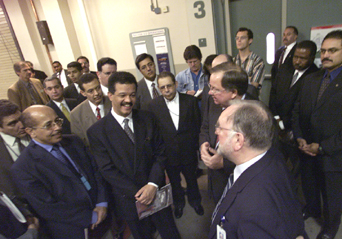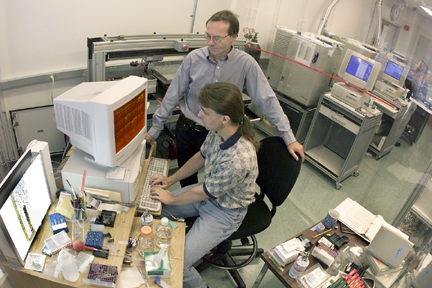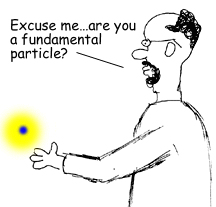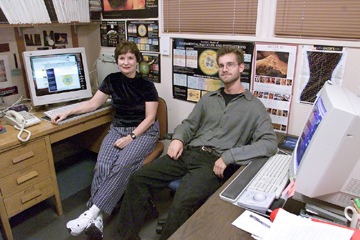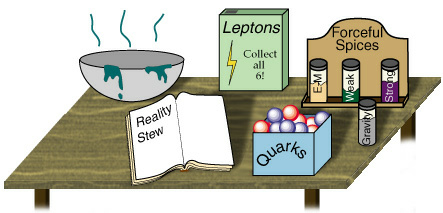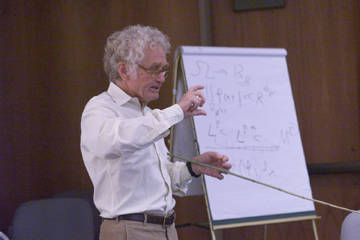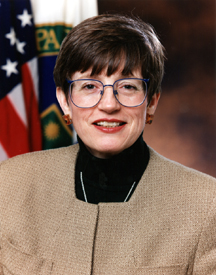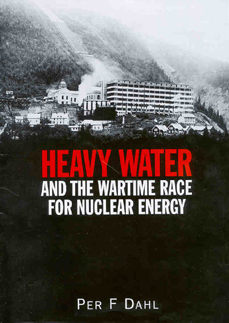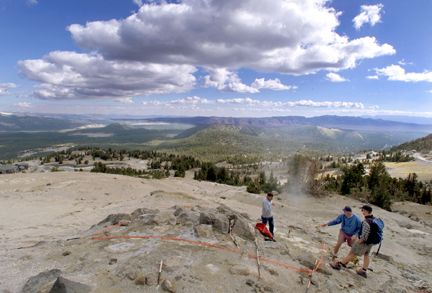
| Dominican President Visits Lab |
ParticleAdventure.org:
Revamped and FUNdamental
|
- Asthma Genes Discovered At Berkeley Lab
- FY2000 Budget Update
- Yuri Orlov on Physics, Human Rights
- Martha Krebs to Resign from Energy Department
- New Search Service For Science Journals
- Berkeley Lab Currents
- Science News
- Lab a Key Player in New UC Berkeley Health Initiative
- Lab Ex-L'er Writes Thrilling Historic and Scientific Account of Heavy Water History
- CLARIFICATION
- Take an Active Stand Against Breast Cancer
- Lab's SHARES Campaign Is Back: Give to Your Favorite Charity
- Currents Online
- Bulletin Board
- Calendar of Events
- Seminars & Lectures
- EH&S Classes - October 1999
- AIM Computer Classes: Oct. - Nov.
- Flea Market
- Flea Market Ad Policy
Dominican President Visits Lab
By Ron Kolb
It had been eight years since an international chief of state (then-German Chancellor Helmut Kohl) set foot at Berkeley Lab. Until last Thursday, when Dominican Republic Pre-sident Leonel Fernandez Reyna and an entourage of more than 60 countrymen from business, university and the media stopped briefly at the Laboratory during their three-day stay in the Bay Area.
During his 75-minute visit at the Lab, Fernandez was given an overview of programs by Director Charles Shank and then escorted to the Advanced Light Source for a tour led by ALS scientific director Neville Smith.
Subsequent regional stops included the UC Berkeley campus and various Silicon Valley high tech firms. His objective, Fernandez said, was to evaluate prospective business and research collaborations that could energize his country's fledgling economy.
"The Dominican Republic is going through a process of moving forward from a free-trade system of assembly plants to a more capital-intensive knowledge-based economy," said the 45-year-old President after his ALS tour. "We are building a cyberpark (in Santo Domingo, the capital), and within it will be an Institute of Technology of the Americas, which will be open to Latin American youth.
"We're studying how we can use science to uplift the economy with new products, especially in the computer science area," he continued. "The idea would be to have an agreement between the [Berkeley] laboratory and the Institute, so our people can be exposed to the scientific brilliance [here]."
Shank agreed, saying, "We would be delighted to have such agreements, since it too would be a great benefit to our science." Though no specific arrangements were established, both parties agreed to continue contacts.
Fernandez is in his third year as President, representing the Dominican Liberation Party. The Bay Area visit also included the country's minister of sports, Juan Marichal, the former San Francisco Giants Hall-of-Fame pitcher who arra-nged attendance for the group at the final baseball game at Candlestick Park.
|
Asthma Genes Discovered At Berkeley Lab
By David Gilbert
Like the sun rising and setting, the simple pro-cess of breathing is something most of us take for granted. Not so, however, if you are one of the 14 million people in the United States who suffer from asthma and other chronic respiratory ailments. For them, catching one's breath can be a real struggle -- sometimes a fatal one.
This month, researchers in Berkeley Lab's Life Sciences Division have announced an important advance in the understanding of this terrible disease: the discovery of two genes that contribute to the development of asthma. The finding suggests that decreasing the activity of these two genes could help reduce susceptibility to asthma attacks.
A team led by Life Sciences' Edward Rubin and Derek Symula working with transgenic mice (mice that carry human genes) found that even subtle changes in the activity of two genes -- IL4 and IL13 -- can have an important impact on asthma susceptibility. Their research results were reported in the Oct. 1 issue of the journal Nature Genetics.
The number of asthma victims has doubled over the last 15 years and is still on the rise for reasons eluding medical science. Children living in urban areas appear to be particularly susceptible. And nearly 5,000 people are expected to die this year from complications related to the disease.
"Thousands of years ago the ancient Greeks observed that asthma ran in families," says Symula, a post-doctoral fellow who joined Rubin's research group nearly four years ago to begin an intensive hunt to identify the genetic factors. "What we knew, at the outset of our studies, was that one region of the human genome, on chromosome 5, tended to be inherited in individuals with asthma."
Rubin's group has previously developed mouse models for a variety of human conditions, including Down syndrome, sickle cell disease, and atherosclerosis. For the asthma study, they decided to forego the conventional approach for identifying genetic links to a specific disease. "Rather than looking at one gene at a time," Rubin says, "we chose to simultaneously examine several genes in parallel, by introducing eight to ten human genes at a time into the genome of mice."
Adds Symula, "We had this several million base pair region from human chromosome 5 that we knew was somehow involved. The strategy was to subdivide the region into a few large pieces of DNA and then introduce these pieces, each composed of several hundred thousand letters of the genetic alphabet coding for several genes, into mice. We expected to then see changes in processes that are controlled by these genes."
By genetically engineering a library of transgenic mice, each containing a different segment of the human genome, Rubin and Symula and the other members of the team were able to rapidly sift through 25 genes located in the genetic interval where the "asthma suspicious" genes had been localized. They then matched physical features, or phenotypes, of these mice with characteristics seen in human asthmatics, to eventually identify IL 4 and IL13 as the genes responsible for asthma-susceptibility in these animals.
Says Rubin, "Although these studies were conducted in mice, not humans, there are several different lines of evidence supporting the role of these interleukins in human asthma-susceptibility."
Interleukins have long been known to play a role in regulating the immune system and, in particular, modulating the inflammatory response. Evolutionarily, IL4 and IL13 are thought to prevent parasitic infection by generating localized inflammation.
Because asthma is a complex genetic condition in which several genes, working in concert, ultimately determine an individual's susceptibility, it posed a major challenge to the traditional approach to genetic research which was used to identify single genes responsible for disorders such as cystic fibrosis and sickle cell disease.
Says Rubin, "The approach we used to pursue asthma genes may now be applied to other common complex genetic conditions, for instance hypertension and obesity, where large genomic regions have been implicated as containing genes contributing to a particular disease."
"This research is a prime example of biology made possible by the DOE's Human Genome Project," Rubin adds. "Our proximity to Jan-Fang Cheng's lab, the actual group engaged in the Joint Genome Institute's mapping effort, led us to investigate this area of research.."
In addition to Rubin and Symula, other contributors to the paper in Nature Genetics were Kelly Frazer, Yukihiko Ueda, and Mary Stevens of Berkeley Lab, and Richard Locksley and Zhi-En Wang of UC's San Francisco campus.
|
ParticleAdventure.org: Revamped and FUNdamental
By Monica Friedlander
Quark Adventure CD-ROM also out
|
"I'm taking philosophy classes right now and it keeps coming up: what's the world made from?" says Charles Groom, a senior at Swarthmore college and one of the students principally responsible for the look and feel of the newly revamped Particle Adventure.
The award-winning educational project was created at Berkeley Lab for high school students, teachers, and general audiences interested in the basics of particle physics. The secret to its success, its creators say, is that it was put together almost entirely by students. In fact, it was Groom and fellow computer science student Joshua Lewis who completely revamped the site this summer under the guidance of Michael Barnett, a physicist in the Particle Data Group who has been involved with the project from the start.
Thanks to their efforts, this month Berkeley Lab is announcing the release of the latest version of the website, complete with its own domain name (ParticleAdventure.org), a more user-friendly navigation system, a new, streamlined organizational structure, and a more professional look.
Also released in conjunction with the upgraded website is a CD-ROM entitled "The Quark Adventure" -- a scaled-down version of the Particle Adventure. Intended mostly for exhibitions and educational settings, the disc also includes an opening slide show.
Upgrades aside, however, both products continue to have a distinctly student-centered look and feel.
Says Michael Barnett, "What really made it work is that students did it all. There is student artwork, student humor, even student text, although we did go back and forth to make sure it's accurate. The students created the organization that made sense to them."
Not only is the material organized in a way comprehensible to laymen, but the tone is that of students talking to their peers. The images, with a few exceptions, were all created by students. In fact, Barnett says, the site has received some criticism for the quality of its art, but he wants to stick with student work.
"We have actually resisted looking too slick," Barnett says. "This is not what we're going for at all. What the students did worked. Why fix what works well?"
It worked so well, in fact, that the site receives millions of hits a year and has garnered almost two dozen major web awards from organizations such as the Discovery Channel, Best of the Web, USA Today, and Education World.
Although a number of educational science websites have sprung up recently (and some may have modeled themselves after the Particle Adventure), nothing was available to educators when Michael Barnett jumped into the fray.
"We started because we felt there wasn't any modern physics in the curriculum," he says. "There weren't any materials to teach it from. The teachers wanted materials."
Project history & content
First came the particle wall chart back in 1988 -- a useful if somewhat daunting color poster with tables and illustrations introducing the standard model of fundamental particles and interactions, created in collaboration with the Contemporary Physics Education Project.
To make the material more appealing, 10 years ago physics teacher Andria Erzberger created what was then the most advanced and user-friendly interactive model -- the hypercard point-and-click system, which came on a black and white floppy disc. (Last year Erzberger was hired by the Lab to run QuarkNet, an educational project involving high school students and teachers to run research experiments.)
Then six years ago, following the advent of the web, the Particle Data Group asked a summer student to convert the project into a full-fledged website, which has since undergone numerous iterations.
As a veteran educator with 20 years of science teaching experience, Erzberger is especially tuned into what it takes to draw youngsters to science. "One thing I found is that students enjoy something new, something that's not well understood -- and especially anything to do with astrophysics and cosmology," she says. "They love areas in which you don't have all the answers, where people make up rules as they go along. It's very different from the traditional way of teaching, where everything is carved in stone."
Erzberger's interest in this discipline is rare among her peers, Barnett says, which is one of the main reasons he felt the need for something like the Particle Adventure. "There are virtually no physics teachers out there who know anything about particle physics," he says. "What we're saying is that there's a way to talk about contemporary physics in your classroom while teaching students the basics of physics."
Following a brief history of the subject, the Particle Adventure jumps head-on into the contemporary understanding of the standard model of particle physics. Also covered are experimental methods (e.g., particle detectors), and finally questions yet to be answered.
The web journey is filled with cartoons, animation, news, quizzes, pop-up windows, and quotes -- all aimed at making the site as attractive as possible -- a sharp contrast to most science websites which are heavy on text and light on fun. In fact, a big part of the Particle Adventure's appeal is its reliance on humor, thanks to the talents of students such as Lewis, who now runs a satire magazine at Swarthmore College.
The organization of the new version of the Particle Adventure is more linear than that of its predecessor, although users can choose their own paths in this 200-page site, traveling in all directions through hyperlinks. A navigation bar with folder-type menus has also been added to keep people from getting lost.
Different approach to teaching physics
But having a good time is not the goal of the Particle Adventure. A key and very unconventional premise is that particle physics can be taught along with, and not after, other basic physics concepts.
"I believe in having a scientifically literate populace," Barnett says. "And teaching people endless details of science is not the best approach to do that. You need to first get them excited about science. You don't do that by studying mechanics or magnetism. You have to learn about these things, but you can learn them by studying particle physics. Learning particle physics is not necessarily an end in itself, but a means of learning all of physics, as well as how we do physics."
So far some half dozen students have worked on the Particle Adventure, which continues to be a work in progress. Groom, who spent two summers at the Lab, and Lewis still work on the project a few hours a week from college. "The Lab is a cool place," says Groom. "You knock on scientists' doors, many of them world authorities, and they are really friendly, always available and helpful. I learned a lot."
|
"If I could remember the names of these particles, I would have been a botanist!"
While surprised by the success of the Particle Adventure, Barnett says he is most touched by the hundreds of e-mails that keep pouring in -- and not just from students and teachers, but from people from over 100 countries, ranging from particle physicists to a judge in Georgia and a rock musician.
"We imagined that a lot of people would use the website in schools, but we never anticipated the breadth of the audience," says Barnett, who also co-authored a soon-to-be-released book on The Charm of Strange Quarks.
Most recently, Barnett's work on the Particle Adventure resulted in a very special payoff for him: an invitation for an all-expense paid trip to this year's Nobel Prize ceremony and banquet. Impressed with the website, the Nobel Foundation has asked Barnett to collaborate with them on an electronic Nobel Museum -- hence the invitation.
For all the success, Barnett tries to keep the project and its subject matter in their proper perspective.
"One of the things the Particle Adventure tries to do is emphasize that we don't have all the answers," he says. "It tries to show how much we've learned, but also tells students, `There are questions that you're going to have to answer."
|
|
FY2000 Budget Update
By Reid Edwards
Last Wednesday President Clinton signed into law the FY 2000 Energy and Water Development Appropriations Bill. Except for energy-efficiency and fossil energy, the legislation funds all DOE research programs, and therefore, most programs at the Laboratory. The bill provides a total of $16.7 billion for the DOE, which represents $390 million below the FY 1999 level and $441 million less than the Administration's request.
A number of contentious administrative issues were addressed in the House-Senate negotiations. The final bill reduces the limit on Laboratory Directed Research and Development (LDRD) from six to four percent and prohibits LDRD to be taken out of the Environmental Management programs. The House had originally propo-sed zeroing out LDRD, while the Senate had supported the existing limit. Berkeley Lab operates at a level of approximately three percent.
Travel by Lab employees was another controversial issue, with the Senate bill mandating a 20 percent reduction from FY 1998, while the House asked for 50 percent reduction. The conference report caps contractor travel in FY 2000 at $150 million -- a 30 percent reduction. The reduction, according to the conference report, is not to be taken across the board but "should be applied to those organizations which appear to have the most egregious travel practices." Additionally, the report language requires contractor employees to follow the same travel rules and regulations as federal employees.
The conference report includes two other staff reductions: a five percent decrease in the number of DOE field office staff and a $15 million funding cut for contractor staff working in the Washington, D.C. area, capped at no more than 270 people.
In scientific areas, high energy physics funding is increased by $16.3 million to $707.9 million. The FY99 funding was $691.6 million, and the request for FY 2000 had been $697.1 million. When the Senate passed its version of this bill, it did not include requested R&D funding for the Next Linear Collider, but the final bill reinstated its funding.
Funding for nuclear physics was also increased above the Administration request. Congress approved $352 million, almost $10 million more than was requested and well over the FY99 funding of $338.5 million. Fusion funding was also increased above the amount requested and the FY99 level to $250 million. Berkeley Lab leads the effort to have a major portion of this increase go to the Inertial Fusion Energy program.
Under the legislation, the funding for DOE's Basic Energy Sciences programs as a whole would decline by $16.4 million to $783.1 million since last year, and well below the requested $888.1 million. Small cuts were made in the BES research program, largely targeted at new funding for Strategic Simulation Initiative-related programs.
The Spallation Neutron Source, a major target for the Congress, was provided the full R&D request of $17.9 million, but only $100 million of the requested $196.1 million for construction.
Biological and Environmental Research programs saw a major increase of $30 million over the Administration's request. As in past years, however, the Congress added a substantial number of specific projects to this portion of the budget, and it is likely that this amount will match the increase.
Finally, Computation and Technology Research took a major hit, as the Congress decided not to fund the Administration's Strategic Simulation Initiative. The amount provided was $132 million, $64 million below the FY 2000 request and $11 million below the FY 1999 budget.
The Interior appropriations bill, which funds DOE's energy efficiency and fossil energy research, is hung up in disputes in Congress. These programs, and much of the federal government, have been funded at FY 1999 levels with a continuing resolution lasting through Oct. 21. These disputes will hopefully be settled by then, although past budget history suggests it may take longer.
Reid Edwards is Berkeley Lab's manager of Government Relations.
Yuri Orlov on Physics, Human Rights
|
Martha Krebs to Resign from Energy Department
By Monica Friedlander
Martha Krebs, the director of the Office of Science and assistant secretary at the U.S. Department of Energy, has announced she will leave the department in early December. She has served at the DOE for the past six years -- the longest period for any director of science in the department's history.
"This kind of service is not meant to be permanent," Krebs said in a letter to the President. "It is time for me to use what I have learned for other places and institutions and, of course, for science."
Berkeley Lab Director Charles Shank praised Krebs, who served as Berkeley Lab's associate director of planning and development during the 1980s and early 1990s.
"Martha Krebs has done a terrific job and leaves a legacy of great accomplishments, both for the Department of Energy and for our Laboratory," Shank said. "She will be remembered for her vigorous efforts in supporting the DOE's and the laboratories' scientific programs. We all owe her a great deal."
A strong proponent of basic research, Krebs availed herself of her position at the DOE to promote scientific research at the highest levels of government. At a 1996 conference on the Human Genome Project she said, "I am in a battle to make it hard for people to ignore the Department of Energy's role in basic science, and harder still for people to say that we as a nation can do without basic science."
Secretary of Energy Bill Richardson expressed his regret at the announcement of Kreb's resignation, and praised her for her leadership in enhancing the role of national laboratories and research universities and for her efforts on behalf of major projects, such as the Relativistic Heavy Ion Collider at Brookhaven National Laboratory and the Joint Genome Institute.
"The Department of Energy and the nation owe Martha Krebs a debt of gratitude," Richardson said in a statement. "During her tenure in the Office of Science, the Department of Energy has emerged as a global leader in science, technology, and technological innovation, and has made groundbreaking collaborations with the scientific community."
Prior to being nominated to her DOE position by President Clinton, Krebs was the first woman to serve as associate director of planning and development at Berkeley Lab from 1983 to 1993. In that position she was responsible for coordinating relationships with federal agencies, technology transfer planning and development, and other areas of organizational development within the Laboratory.
A physicist, Krebs has always felt at home at Berkeley Lab. "I always look forward to coming back to Berkeley to see people excited about science, and people who can communicate that excitement," she said in 1997.
Krebs began her career in government in 1975 for a science division of the Library of Congress. Subsequently she served on the House Committee on Science and Technology as the staff director of its Subcomittee on Energy Development and Applications.
|
New Search Service For Science Journals
Starting Oct. 1 the public will have easier online access to scientific journal articles thanks to a new web service developed by DOE's Office of Scientific and Technical Information (OSTI). PubSCIENCE, at http://www.osti.gov/pubsci, focuses on the physical sciences and other energy-related disciplines. Its user-friendly search system provides the scientific and educational communities with a means to quickly identify and locate journal articles without having to navigate through multiple websites. Users can search hundreds of citations and then link directly to the publication. Access to the full text, however, will require a subscription, site license or pay-per-view arrangement. Some 500 journals will be searchable now, with the number expected to increase rapidly.
Technical questions concerning PubSCIENCE may be directed to R. L. Scott at OSTI at (423) 576-1193. For more information about the project contact OSTI Director Walter L. Warnick at (301) 903-7996.
Berkeley Lab Currents
Ron Kolb, PID department head.
EDITOR: Monica Friedlander, (510) 495-2248, msfriedlander@lbl.gov
STAFF
WRITERS: Paul Preuss, 486-6249; Lynn Yarris, 486-5375
CONTRIBUTING WRITERS:
Jon Bashor, X5849; Allan Chen, X4210, Jeffery Kahn, X4019
FLEA MARKET /
CALENDAR: Jacqueline Noble, 486-5771
fleamarket@lbl.gov /
currents_calendar@lbl.gov
Public Information Department, Berkeley Lab, MS 65A
One Cyclotron Road,
Berkeley CA 94720
Tel: 510/486-5771 Fax: 510/486-6641
Berkeley Lab is managed by the University of California for the U.S. Department of Energy.
Science News
Lab a Key Player in New UC Berkeley Health Initiative
Berkeley Lab will play a critical role in an innovative new Health Sciences Initiative announced on Wednesday by UC Berkeley. The half-billion-dollar research package will unite physical and biological scientists and engineers -- as many as 400 researchers from fields like biology, public health, psychology, physics, chemistry, engineering, mathematics and computer science -- in interdisciplinary research that promises to redefine the way biology is studied in the new century.
In addition to the Lab's expertise in these fields and the participating joint campus-faculty appointments, Lab programs like the Advanced Light Source and Genome Sciences will contribute the cutting-edge tools that will enable much of the work to take place.
The initiative provides for two new facilities on campus, to be built for $300 million, which will house many of the technologies needed to advance disease prevention and diagnosis, drug development, and patient evaluation and therapy.
Further details on the initiative and Berkeley Lab's role in it will be presented in the next issue of Currents.
Lab Ex-L'er Writes Thrilling Historic and Scientific Account of Heavy Water History
By Paul Preuss
Heavy Water and the Wartime Race for Nuclear Energy, by Per F. Dahl, Institute of Physics Publishing, 1999; 399 pages
Late in 1938, Lise Meitner, Otto Hahn and Fritz Strassman discovered the phenomenon of atomic fission (see the last issue of Currents, Sept. 24, for a discussion of Meitner's role in the discovery). Physicists everywhere realized that if chain reactions could be tamed, fission could lead to a promising new source of power.
What was needed was a substance that could "moderate" the energy of neutrons emitted in radioactive decay, so that they could be captured by other fissionable nuclei. Heavy water was a prime candidate for the job -- and its role in world affairs was thus forever assured.
Physicist and author Per Dahl, a vice-president of Berkeley Lab's Ex-L's, is just the man to tell the story. With his newest work of science history, Heavy Water and the Wartime Race for Nuclear Energy, Dahl pulls off the remarkable feat of delivering both a scholarly work and a nail-biting thriller.
While plenty of books and movies have dealt with Allied efforts to deny heavy water to the Germans in World War II, Dahl's is the first history of the substance itself -- not as "a purely technical treatise," he writes in the preface (although there are details and diagrams aplenty), but as "a social history."
It is curious to be reminded, from a late twentieth-century understanding of how matter is constituted, that deuterium, 2H, an atom whose nucleus includes one neutron, was discovered before the neutron itself. In 1931, most scientists thought the differing weights of isotopes were due to extra protons bound to "nuclear electrons."
That year, at Columbia University, Harold Urey found the spectral lines of 2H in commercial hydrogen gas and, by Thanksgiving, identified it in a few cubic centimeters of concentrated liquid hydrogen. In February 1932, in Cambridge, England, James Chadwick discovered the neutron -- taking his cue from Irène and Frédéric Joliot-Curie, who had observed the effects of neutrons but misinterpreted them.
Deuterium is physically so different from ordinary hydrogen (roughly twice as massive, for one thing) that chemists eagerly turned their attention to it. They wondered what differences deuterium instead of ordinary hydrogen might make in the behavior of chemical compounds; what the effects on plants and animals of water with two deuterium atoms per molecule might be; and even what therapeutic potential this literally heavy water might possess.
The protean Gilbert Lewis, Urey's mentor at UC Berkeley, was a pioneer in these investigations, and he soon made more heavy water than Urey himself -- enough that, among many other experiments, he was able to feed two-thirds of a gram of the precious stuff to a mouse. The mouse survived, Lewis reported, but showed "marked signs of intoxication."
Concentrating heavy water requires enormous amounts of electricity. In the 1930s, one of the few places in the world with power to spare was the Vemork plant of Norway's Norsk Hydro-Elektrisk, which had harnessed a 144-meter-high waterfall to produce fertilizers. Norsk Hydro supplied the world's scientific community with heavy water only as a sideline. Inebriated mice aside, what was it good for?
Nuclear fission supplied the answer. The best candidates for moderators in atomic piles were heavy water and pure graphite. Dahl relates the fascinating events, including romantic distractions, that persuaded German scientists that graphite wouldn't do the job. When, in late 1939, the Germans began ordering heavy water in very large quantities, Norsk Hydro management suspected "some kind of deviltry."
Frédéric Joliot knew perfectly well what kind of deviltry, and with the cooperation of Norsk Hydro, the French managed to spirit the company's entire stock of heavy water, some 185 kilograms, out of the country under the noses of watchful German agents. Later, most of it was carried out of Vichy France by Joliot's assistants, Hans von Halban and Lew Kowarski, to Cambridge, where they convinced the Bri-tish that chain reactions were practical.
(A further series of unlikely events led Halban and Kowarski to pioneer the Canadian nuclear program, and eventually supply the thousand metric tons of heavy water that fills the great central sphere of the Sudbury Neutrino Observatory, in which Berkeley Lab plays a major part.)
Meanwhile the Germans had invaded Norway, and the Allies set out to destroy Vemork, a story familiar from the 1965 Hollywood film, Heroes of Telemark, starring Kirk Douglas and Richard Harris. (Dahl says the Norwegians made a much better film version, "but unfortunately it's in Norwegian.") Despite tragic loss of life, the Norwegian underground repeatedly sabotaged Vemork's heavy water production until the Germans finally gave up.
The German attempt to build a reactor was feeble and disorganized -- and their effort to build an atomic weapon nonexistent -- but the Allies didn't know that. German interest in heavy water was a major factor in the race to build the A-bomb.
Per Dahl masterfully recounts all these events and many more. There is wisdom in his judicious treatment of persistent historical debates, including the rancorous argument that still rages about the motivations of Hahn, Werner Heisenberg, and the other members of the German "Uranium Club." His style is lively, his research thorough, his organization superb.
Fortunately the Institute of Physics Publishing, a British concern, has matched Dahl's efforts by giving Heavy Water and the Wartime Race for Nuclear Energy the scholarly apparatus and handsome production it deserves.
|
CLARIFICATION
"Microbes in Basalt Thrive on Toxic Waste," Currents, Sept. 10
Transuranic, low-level, and mixed wastes are stored at the National Engineering and Environmental Laboratory's Radioactive Waste Management Complex, not high-level waste.
Take an Active Stand Against Breast Cancer
Lab team joins walk on Saturday, Oct. 24
It is time again to lace your walking shoes and join other Lab colleagues for a stroll in Golden Gate Park as part of a national effort to fight breast cancer.
This deadly disease is responsible for more than 40,000 deaths a year. To help in the fight against breast cancer, an estimated 150,000 people from all walks of life will participate in Making Strides Against Breast Cancer, a nationwide series of non-competitive walking events sponsored by the American Cancer Society to heighten awareness about the disease and raise money for research.
The event is part of a series of activities marking October as Breast Cancer Awareness Month.
In the Bay Area the second annual five-mile Making Strides walk will take place on Oct. 24 in Golden Gate Park. Berkeley Lab is joining the effort by organizing its own team for the event. To join, contact team co-captains Sonia Mueller (X5944, smmueller@lbl.gov) or Carol Harris Earls (X2859, chearls@lbl.gov).
The walk will start at Speedway Meadow, with registration between 8:00 and 9:00 a.m.
Those who cannot participate are encouraged to sponsor a walker, volunteer, or make a contribution (make checks payable to the American Cancer Society and send them to Sonia Mueller at MS 50A-4119).
Now in its sixth year, Making Strides Against Breast Cancer has raised over $20 million for research, education and outreach programs on local and national levels. This year's events will be held in 29 cities in the United States. The American Cancer Society hopes to raise $14 million through this national effort. Give them your best effort.
Note: A breast cancer information group is currently being organized at Berkeley Lab. More information will be forthcoming in the next issue of Currents.
Lab's SHARES Campaign Is Back: Give to Your Favorite Charity
By Jon Bashor
Beginning on Nov. 1, Lab employees will again have the opportunity to participate in the Laboratory's annual charity giving campaign -- Berkeley Lab SHARES (Science for Health, Assistance, Resources, Education and Services).
The project, which was revived last year and raised $60,000 for non-profit organizations in the area, allows employees to either make a one-time contribution or to sign up for automatic payroll deduction. Those who contribute to the campaign will be eligible to win prizes in drawings held each week of the fundraising effort.
"Although we were gratified by last year's response, we feel we can do even better this year," said Ron Kolb, head of the Lab's Public Information Department and coordinator of this year's SHARES campaign.
To help guide the campaign this year, a labwide SHARES policy board has been created, chaired by Lab Director Charles Shank. Other members are Pier Oddone, Michael Chartock, Ron Kolb, Terry Powell, Gordon Wozniak, Robin Wendt, Howard Matis, William Barletta, Ken Woolfe, Neville Smith, Henry Vanbrocklin, Eric Norman, Stewart Loken, Richard C. Diamond, Mary Barcellos-Hoff and Sally Benson.
Berkeley Lab SHARES lets employees choose from hundreds of non-profit organizations represented by four umbrella organizations: Community Health Charities, United Way Bay Area, EarthShare of California, and the Bay Area Black United Fund. Organizers have also decided to include specially chosen Bay Area organizations with links to the Laboratory and its mission, particularly in the area of science education. Employees also have the option of writing in the name of any organization which meets the requirements of 503b of the Internal Revenue Code.
Information packets and participation forms will be distributed by SHARES representatives in each division on Monday, Nov. 1.
Employees who wish to participate need to return their forms in the preaddressed envelope by Nov. 24. Donations can be made either by enclosing a check or opting for payroll deductions, which take effect in January 2000.
Two SHARES Fairs will also be held: on Oct. 27 in downtown Berkeley (Bldg. 937) and on Oct. 28 at the Lab cafeteria. The fairs give employees an opportunity to learn first-hand about the participating organizations and about how the donations will be used.
Further information will be published in upcoming issues of Currents.
Currents Online
The full text and photographs of each edition of Currents are published online at http://www.lbl.gov/ Publications/Currents/. The site allows users to do searches of past articles going back to 1994.
Bulletin Board
|
Tech Fair to Showcase Lab and Vendor Products & Services
On Monday, Oct. 25, the Federal Business Council will sponsor a second Information Technology Expo from 10:00 a.m. to 2:00 p.m. in Perseverance Hall.
The event is part of a series to provide government employees with information about different information technology products and vendor services.
More than two dozen companies will attend, including manufacturers and vendors of workstations, desktop and laptop computers, communication products, displays, software, and other high tech products.
The Lab's Computing Infrastructure Support Department will also have its own displays featuring the Computer Support Help Desk, onsite computer training, and the services of the Unix Support Group.
Extras will include refreshments and a drawing for prizes, such as free onsite computer support services.
A list of exhibitors will be posted on the event website (http://fedpage. com/events/) beginning Oct. 11. You may also register for the event through that site.
Flu and Pneumonia Shots
With the flu season just around the corner, Health Services is once again offering Lab employees 18 and older low-cost flu and pneumonia shots. The vaccinations will be given from 8:00 a.m. to noon on consecutive Thursdays, Oct. 21 and Oct. 28, in Bldg. 26.
The cost this year is $12 for the flu shot and $25 for the pneumonia vaccine.
Health officials encourage vaccination for people over the age of 65 and anyone suffering from heart, lung or other serious health problems. Health Services also suggests that people contact their personal physician for any questions regarding the vaccine.
To make an appointment call X6266.
The vaccination program is made possible through the Visiting Nurse Association and the Hospice of Northern California (VNAHNC). Payment may be made by cash or checks, payable to VNAHNC.
Training for Lab's Integrated Disability Program
Three two-hour training sessions on the Lab's new integrated disability management program will be offered for managers, supervisors and other Lab employees involved in this program. The training will review worker compensation forms and procedures, non-industrial disability processes, and related laws.
The workshops will be held in the Bldg. 66 auditorium on the following dates:
Monday, Nov. 15, 1:00 - 3:00
Tuesday, Nov. 16, 8:00 - 10:00
Weds., Nov. 17, 10:00 - 12:00
To enroll or for more information contact Azucena M. Coronel at X5213 or AMCoronel@lbl.gov.
New Computer Training Center
Beginning Oct. 12, the Environment, Health and Safety Division will open a new Computer Based Training (CBT) Center in Bldg. 51L. The facility will allow Laboratory staff to take selected EH&S training courses via computer instruction during scheduled CBT hours: Tuesdays and Thursdays from 1:00 to 4:30 p.m. and Wednesdays from 8:00 to 11:30 a.m.
Courses to be offered initially include Forklift Recertification (EHS 0226), Crane and Hoist Operator Recertification (EHS 0207), and Blood Biosafety Refresher (EHS 0738).
In addition, at 10:30 a.m. and 1:30 p.m., employees may view a PC video broadcast of Introduction to EH&S at LBNL (EHS0010) for credit.
For more information contact Susan Aberg at X7366 or Jack Salazar at X6571.
New Employee Orientation Session
This month's New Employee Orientation will be held on Tuesday, Sept. 14, starting at 9:00 a.m. in the Bldg. 50 auditorium. The session starts with the required safety training (EH&S 10), followed by orientation to Berkeley Lab.
Postdoc Fellow Reception
The Annual Postdoctoral Fellow Reception will be held at the Bancroft Hotel in Berkeley on Thursday, Oct. 21, from 4:00 to 6:00 p.m. All postdoctoral scientists at Berkeley Lab are invited to attend.
Calendar of Events
October 8 - 22, 1999
General Interest
MON, OCT. 11
Gay & Lesbian Assoc. organizational meetingLunch, contact Paul Harris (X4650)
TUES., OCT. 12
New Employee Orientation9:00 a.m., Bldg. 50 auditorium
WED., OCT. 13
Music Club12:00 - 1:00, lower cafeteria
FRI., OCT. 15
Runaround XXII12:00, starts at Firehouse
THURS., OCT. 21
Flu & Penumonia Shots8:00 - 12:00, Bldg. 26
Call X6266 for appointment.
Postdoc Fellow Reception
4:00 - 6:00, Bancroft Hotel
Dance classes are held Mondays from noon to 1:00 on the lower level of Bldg. 51. Martial arts classes are held every Monday and Wednesday from 5:00 to 6:15 p.m. at the same location.
Seminars & Lectures
MON., OCT. 11
PHYSICS DEPARTMENT COLLOQUIUM"Massive Thoughts" will be presented by Young Kee Kim of UCB's Physics Department.
4:30 p.m., 1 LeConte Hall
TUES., OCT. 12
LIFE SCIENCE DIVISION"Proteases to Die For" will be presented by Junying Yuan of Harvard University.
4:00 p.m., Bldg 66 aud.
THURS., OCT. 14
ASTRONOMY COLLOQUIA"High-Z Reionization" will be presented by Miralda-Escude of Harvard University.
4:30 p.m., 2 LeConte Hall
LBNL PHYSICS GROUP
"HERMES and the Spin Structure of the Nucleon"
will be presented by Ralf Kaiser of DESY Zeuthen, Germany.
4:00 p.m., Bldg
50A- 5132
WED., OCT. 18
PHYSICS DEPARTMENT COLLOQUIUM"Quantum Computing with Atoms" will be presented by Christopher Monroe of the National Institute of Standards and Technology.
4:30 p.m., 1 LeConte Hall
TUES., OCT. 19
CENTER FOR ENVIRONMENTAL BIOTECHNOLOGY"The Significance of New Technologies for Cleaning Munitions Ranges" will be presented by Lenny Siegel of San Francisco State University.
Noon, Bldg. 50A-5132
WED., OCT. 20
ENVIRONMENTAL ENERGY TECHNOLOGIES DIVISION"Quantitative Analysis of Variability and Uncertainty in Emission Inventories" will be presented by Chris Frey of North Carolina State University.
2:30 p.m., Bldg 90-3148
THURS., OCT. 21
ASTRONOMY COLLOQUIA"Galaxy, Galaxy Lensing" will be presented by Priya Natarajan.
4:30 p.m. 2 LeConte Hall
MATERIALS SCIENCES DIVISION
"From Model Studies in Surface Science to
Tailored Catalysts" will be presented by Norbert Kruse of Free University of
Belgium, Brussels.
1:30 p.m., Bldg 66 auditorium
LBNL PHYSICS GROUP
"Muon Storage Rings as a Source of Neutrino Beams"
will be presented by Andrew Sessler.
4:00 p.m., Bldg 50A-5132
FRI., OCT. 22
EARTH SCIENCES DIVISION"Water Management in the Pre-Columbian Peru: The Fountains of the Sacred Valley" will be presented by Jerry Fairley of Earth Sciences.
11:00 a.m., Bldg 90-2063
EH&S Classes - October 1999
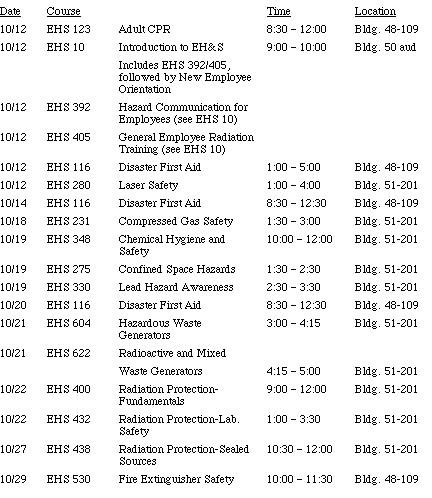
For more information or to enroll, contact Susan Aberg at Saberg@lbl.gov or enroll via the web at http://www-ehs.lbl.gov/ehstraining/registration/. Preregistration is required for all courses except EHS 10 (Introduction to EH&S). Times and locations are subject to change. For a full, updated schedule of EH&S training sessions see http://www-ehs.lbl.gov/schedule/.
AIM Computer Classes: Oct. - Nov.
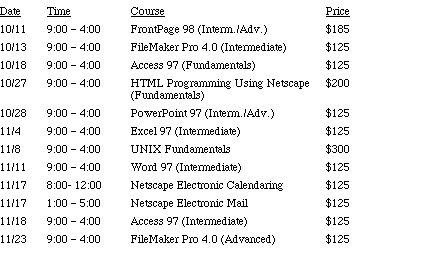
Classes are held in Bldg. 51L on PCs with Windows 95. The material covered is applicable to users of a Mac 6.x series or an older Mac or PC version. For more information look up the class website at http://www.lbl.gov/Workplace/EDT/computers/PC_Classes.html or contact Heather Pinto at X4181.
Flea Market
Autos/Supplies
`98 TOYOTA, Rav 4, green, 2x4 WD, at, ac, power steer/wndw/ lock, alarm, am/fm/cass/CD, 14k mi, $18,000/bo (moving sale), Giovani, X7260, 841-2066`95 HYUNDAI Sonata, 4 dr sedan, 60K, auto, 6 cyl/3.0L, dual air bag, ac, am/fm/cass/CD, sunroof, pwr steer/wndw/lock, $7,500, Yoonho, X5305, 232-2751
`92 JEEP WRANGLER, 4X4, 4 cyl, 5 spd, pwr steer, 62K mi, exc cond, $7,990, Steve, X7855, (925) 682-6008
`91 ACURA Integra, GS-Hatchback, 82K mi, alarm, sunroof, alloy wheels, original owner, $8,500, Peter X5983 or Patty (925) 687-1827
`89 FORD Bronco, 4x4, full size wagon, 1 owner, all receipts, recent smog cert/tune-up, new tires & brakes, 5 spd/od, pwr steer/brakes/wndw/lock, ac, am/fm/cass, runs fine, $5,000, Thomas, X8617, 430-1736 eves
`89 FORD Bronco II, 2WD, 171K, new engine at 128K, exc cond, maint records, new trans/ brakes/radiator/fuel pump/tires, auto/OD, pwr steer/brakes/ wndw/lock, ac, cruise, am/fm/ CD, ski rack, $5,500, Oliver, X5861, 981-0235
`89 NISSAN Sentra, 2 dr, CD, 170K mi, $700/bo, Valerie, X4196, 525-1275 (eve)
`89 TOYOTA Camry, DX V6 24 valve fuel inj, 5 spd, pwr steer/ wndws/locks, cruise, am/fm, moonroof, dual bike rack, ski rack, chains, blue/blue, 98K mi, 1 owner, all records, exc mech, good body, $4,800, Mark, X7087, 486-8079
`89 FORD Tempo, 4dr, very good cond, 140K, pwr steer/brake/ locks, cruise, am/fm/cass, exc tires, new starter/fuel pump, $2,150, Dave, X8150 or 925/462-5357
`89 HONDA Civic, CRX hatchback, 5 spd, air cond, sunroof, am/fm/cass, red w/ black interior, good tires/brakes/clutch, runs great, well-serviced, $2,750, James, X5457, 597-0911
`89 MAZDA 626 Turbo Sedan, 4 dr, sunroof, lift-back, blue, exc cond, all power, a/t, ac, am/fm/ cass, 104K mi., $3,700, Michael, X5650, (925) 947-1111
`87 DODGE Colt E Sedan, 5 spd, 4 dr, am/fm/cass, 148K mi, runs good, $1,600/bo, Andre, X5600, 486-2383
`85 FORD Tempo, 117K, 5 spd, runs great, new catalytic converter, muffler and radiator, pwr steering, $1,000, Simon, 642-1440
`84 HONDA Civic Hatchbck, 4 spd, ac, 1 owner, all records, 104K mi, will smog, new tires, runs great, $1,450, Worley, 527-3869
Housing
EL CERRITO HILLS, furn room, bay view, household privileges, incl util wash/dry/kitchen, 15 min from Lab, $600/mo, Larry, X5406, 235-9268NORTH BERKELEY, exc neighborhood, convenient location, furn room, pleasant non-smoking household, $550/mo, incl util, Palma, 528-8155
BERKELEY, 2 bdrm house, 15 mins walk to downtown, furnished, share yard/laundry, avail Nov. 11, $2,000/mo, non-smokers, Chris, X7028
BERKELEY, 2 bdrm house, quiet neighborhood, 15 mins walk west of downtown, recently restored, furnished, hardwood floors, fireplace, lge living/dining rm, share yard/laundry, avail Nov. 1, $2,000/mo, non-smokers, Chris, X7028
BERKELEY, Elmood area, furn 1 bdrm, split-level, linen, dishes, HiFi, VCR, microwave, sunny, quiet, safe; walk to UC, hill view from large terrace, garage; prefer one mature, neat, nonsmoking visiting researcher, minimum 10 mo, $880/mo, leave name, phone number and e-mail, 843-6325
Miscellaneous
CHILD SEAT, Century 3000 STE, $30, umbrella stroller, Kolcraft, $15, Victor, X7030DESK, Danish style, rolltop, 4 drawers, space for computer and typwriter, steel cupboard, 2 drs, 5 shelves, green, call 524-0075
HEALTHCLUB MEMBERSHIP, Lakeridge Health Club, El Sobrante, single $200, $68/mo, olympic pool, tennis, handball, sauna/hot tub, more, Louise, X5547, (925) 254-7670 (eve)
FIREWOOD, well seasoned, 1/4 cord, $20/bo, you haul, Oakland, Ken, X7739, 482-3331
FRAME, double bed, light colored hardwood, $80; poposan chair, $35; 42" dia kitchen table w/ 4 chairs $40; 30"x30" to 50" teak table $35; more, Worley, 527-3869
GARAGE SALE, Guatemala fabric, handicrafts, books, bikes, houseware and furniture, Oct. 9-10, Berkeley, 1815 Blake St off Martin Luther King, David, X4127
MOVING SALE, queen sz mattress & frame, $120; 2-seat sofa, $120; JVC 20" TV w/ remote, $75; sm ent center, $30; coffee table, $40; more, Nov 10, Chris-toph, X7550, (925) 363-4437
MOVING SALE, 10 spd Raleigh bike $90; new Sharp portable TV/VCR, $125; Akai stereo set $90; Swedish pine table and chairs $90; var household items, James, X5457, 597-0911
NORDIC TRACK, exc cond, $150, Carlos, X4227, (415) 584-2038
OPERA TICKETS, Berg's Woz-zeck, 1/5, exec seats, $240/pair, Esther, X5306, 843-7678
PENTIUM NOTEBOOK, 120 MHz Compaq Presario 1020, 1 GB hardrive, 32 MB RAM, passive color screen, built-in modem, CD-ROM & stereo speakers, $500, John, X7279, 528-2723
SAILBOARDS, '94 Kinetic high wind slalom board, 8'-9", like new, $245; '89 Fanatic Ultra Mamba, 8'-6", exc, $125, David, X6797, 236-4347
SERVICE, interior painting, free estimate, Rita, X5621, 465-3813
SOFA, sectional, patio/lawn furniture, Peter, X4157, 525-3290
TICKETS (4), Bruce Springsteen, avail at cost, sold-out show, 10/25, Oakland Arena, will sell in pairs, Victor, X7030, or Bob, 524-0634
THULE RACK, bike and skis w/ lock, for small car, $250, Worley, 527-3869
VACUUM CLEANER, new upright DirtDevil $85; juicer, waffle maker, coffee grinder, foam camping mattress, tarpauline 4x5 yards, 2 sleeping bags, bicycle pump, wood laudry rack, metal music stand, Andreas, X5453
WINDSURF SAILS, Windwing, '95 single cam 4.4, (4) '95 to '97, race sails 5.2 to 6.8, '93 ART 7.5, all like new, $75 - $175, David, X6797, 236-4347
Wanted
ELECTRONIC VACUUM TUBE TESTER, Dennis, X8605, (925) 938-2196FAMILY TO SHARE BABYSITTER, exc individual, prefer 4-to-12 mo, 5 min from LBNL, Jiamin, X6004 or X7176
FIRST TWO EPISODES of "The Sopranos" series, shown this year on HBO, Ted, X4886, 339-0598
HOUSING, visiting prof, 2 or 3 bdr/2 bth house or apt, N. Ber-keley/ Kensington/Albany areas, 3/1-5/30, non-smoker, no pets, very responsible, fully or partially furnished, Peter, 642-8087, pyyu@lbl.gov
HOUSING, Israeli family, 3 bdrm house/apt, Berkeley area, 3/15 - 7/31, or exchange for 3 bdrm apt in Baka section of Jerusalem, 15 min walk from town, Arnie and Nechama, adruck@netvision. net.il
SAXOPHONE, beginning student, Steve, 495-2214, (925) 833-8531
Vacation
TAHOE KEYS, South Lake Tahoe, 3 bdrm, 2-1/2 bth house, fenced yard, quiet area, close to many attractions, private dock, great views of water/mountains, $150/night, 2 night min, Bob (925) 376-2211SO LAKE TAHOE, spacious chalet in Tyrol area, close to Heavenly, peek of Lake from porch, fully furn, sleeps 8+, sunny deck, pool, spa in Club House, close to casinos, shopping, more, $125/night, Maria, 724-9450
Carpool
NEED 2 riders, from SF (Miraloma Park) to LBNL, leave 8 a.m., return 5:15 p.m., Carlos, X4227, (415) 584-2038
Flea Market Ad Policy
Ads are accepted only from LBNL employees, retirees, and onsite DOE personnel. Submissions must include name, affiliation, extension, and home phone number.Ads must be submitted in writing -- via e-mail (fleamarket@lbl.gov), fax (X6641), or delivered/ mailed to Bldg. 65B. No ads are taken over the phone.
Ads will be repeated only as space permits. The deadline for the Oct. 22 issue is Friday, Oct. 15.
